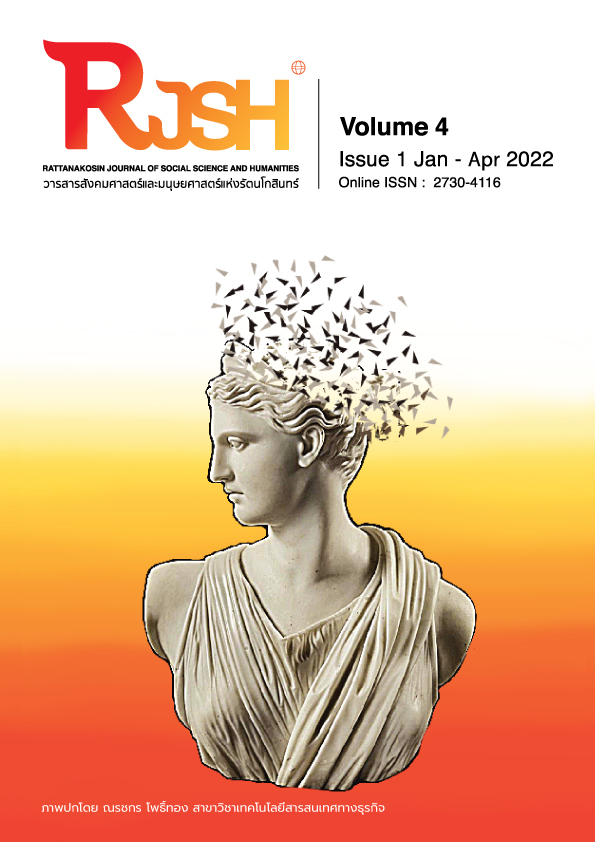The Patterns of an Occupational Standard and Professional Qualifications: Case Study of Fashion Design in Thailand
Main Article Content
Abstract
This qualitative research aimed to develop occupational standards and measure the professional qualification of fashion designers in Thailand. The focus group was Thai fashion designers of 3 levels who were assessed according to occupational standards and professional qualifications by using the 5-levels standard measurement. The process was 1) drafting the pattern of the occupational standard by analyzing roles and creating duty diagrams 2) publicizing and certifying the occupational standard 3) drafting the professional qualification and classifying by roles and capabilities. 4) publicizing and certifying the professional qualification standard 5) assessing individuals into fashion designers of 1-3 levels 6) evaluating the appropriateness of the occupational standard and the professional qualification of fashion designers in 7 components. The results showed that the development of occupational standards of fashion designers consisted of 1 goal, 4 roles, 12 duties, and 50 capabilities. The professional qualification of fashion designers was divided by the sequence of duties that were clothing fashion designers in level 1-6, leather fashion designers in level 1-6, and fashion stylists in level 2-4. The conclusion of the clothing fashion designer assessment revealed that 10 samples of level 1 passed with 100%, 10 samples of level 2 passed with 100%, and 10 samples of level 3 passed with 90%. The appropriateness of the occupational standard and the professional qualification of fashion designers was at a high level with an average of 3.75 and a standard deviation of 0.81; that could be applied to use.
Article Details
The content within the published articles, including images and tables, is copyrighted by Rajamangala University of Technology Rattanakosin. Any use of the article's content, text, ideas, images, or tables for commercial purposes in various formats requires permission from the journal's editorial board.
Rajamangala University of Technology Rattanakosin permits the use and dissemination of article files under the condition that proper attribution to the journal is provided and the content is not used for commercial purposes.
The opinions and views expressed in the articles are solely those of the respective authors and are not associated with Rajamangala University of Technology Rattanakosin or other faculty members in the university. The authors bear full responsibility for the content of their articles, including any errors, and are responsible for the content and editorial review. The editorial board is not responsible for the content or views expressed in the articles.
References
คุณวุฒิวิชาชีพของไทย. (2012). รูปแบบในการจัดตั้งคุณวุฒิวิชาชีพ. สืบค้นเมื่อ 3 กันยายน 2564 จาก: http://www.thaivq.org/index.php?option=com_content&view=category &id=30&Itemid=37.
จะเด็ด เปาโสภาและมนตรี พรหมเพ็ชร. (2548). การพัฒนาสมรรถนะวิชาชีพ เล่ม 2 การพัฒนาโมดูนแบบฐานสมรรถนะ. สำนักมาตรฐานการอาชีวศึกษาและวิชาชีพ สำนักงานคณะกรรมการอาชีวศึกษา กระทรวงศึกษาธิการ, 1-6.
ชูศรี วงศ์รัตนะ. (2546). เทคนิคการใช้สถิติเพื่อการวิจัย. กรุงเทพมหานคร: เทพเนรมิตรการพิมพ์.
ธีรพงษ์ วิริยานนท์. (2549). การพัฒนามาตรฐานอาชีพของผู้ประเมินสมรรถนะวิชาชีพตามระบบ คุณวุฒิวิชาชีพ. วิทยานิพนธ์ครุศาสตร์อุตสาหกรรมดุษฎีบัณฑิต สถาบันเทคโนโลยีพระจอมเกล้าพระนครเหนือ.
บัญชา วิชยานุวัติ. (2550). การพัฒนารูปแบบมาตรฐานอาชีพเพื่อประยุกต์ใช้ในประเทศไทย.
สืบค้นเมื่อ 3 กันยายน 2564 จาก http://thaivq.org/index.php?option=com_ content&view=article&id=18: 2012-03-22-14-49-43&catid=30:the-community&Itemid=37.
ประคอง กรรณสูต. (2528). สถิติเพื่อการวิจัยทางพฤติกรรมศาสตร์. พิมพ์ครั้งที่ 3. กรุงเทพฯ: ศูนย์หนังสือ ดร.ศรีสง่า.
ภควัต เกอะประสิทธิ์ ธีระพงษ์ วิริยานนท์ และวัลลภ จันทร์ตระกูล. (2564). การพัฒนารูปแบบการฝึกอบรมสมรรถนะวิชาชีพช่างไฮดรอลิกส์อุตสาหกรรม. วารสารวิชาการสถาบันเทคโนโลยีแห่งสุวรรณภูมิ, 7(1): 29-43.
มลวิภา ภูลสนอง ธีรพงษ์ วิริยานนท์ และณภัทร ยศยิ่งยง. (2560). การจัดทำมาตรฐานอาชีพ และคุณวุฒิวิชาชีพ สาขาอาชีพช่างตัดเย็บเสื้อผ้า. วารสารการพัฒนาเทคนิคศึกษา มหาวิทยาลัยเทคโนโลยีพระจอมเกล้าพระนครเหนือ, 29(102): 125-132.
อัคครัตน์ พูลกระจ่าง และวนิดา ฉินนะโสต. (2560). การพัฒนามาตรฐานอาชีพและคุณวุฒิวิชาชีพสาขาวิชาชีพอนุรักษ์งานพื้นบ้านและงานศิลปหัตกรรม. วารสารวิจัยและพัฒนา วไลยอลงกรณ์ ในพระบรมราชูปถัมภ์, 12(1): 15-25.


